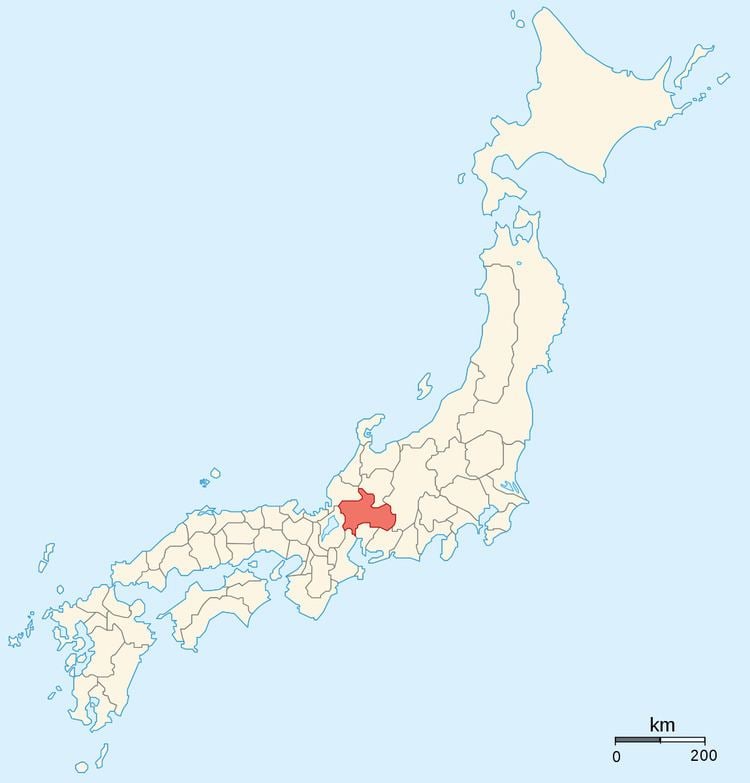Mino Province (美濃国, Mino no kuni), one of the old provinces of Japan, encompassed the southern part of modern-day Gifu Prefecture. It was sometimes called Nōshū (濃州). Mino Province bordered Echizen, Hida, Ise, Mikawa, Ōmi, Owari, and Shinano Provinces.
Although the ancient provincial capital was near Tarui, the main castle town was at Gifu, the home of Inabayama Castle.
In 713, the road crossing through Mino and Shinano provinces was widened to accommodate increasing numbers of travelers.
Mino Province served an important military and political role as the path to Kyoto as well as to Tokaido.
During the Kamakura and Muromachi Period, Mino Province was governed by the Toki clan and later in Azuchi period controlled by Oda Nobunaga. His heirs continued to control it after Nobunaga and Toyotomi Hideyoshi took power.
The Battle of Sekigahara took place at the western edge of Mino, near the mountains between the Chūbu Region and the Kinki Region.
Gifu PrefectureAnpachi District (安八郡) - absorbed parts of Taki District; but lost parts to Kaisai and Shimoishizu Districts to become Kaizu District (海津郡) on April 1, 1896Atsumi District (厚見郡) - merged with Kakami and parts of Katagata Districts to become Inaba District (稲葉郡) on April 1, 1896Ena District (恵那郡) - dissolvedFuwa District (不破郡)Gujō District (郡上郡) - dissolvedHaguri District (羽栗郡) - merged with Nakashima District to become Hashima District (羽島郡) on April 1, 1896Ikeda District (池田郡) - merged with parts of Ōno (Mino) Districts to become Ibi District (揖斐郡) on April 1, 1896Ishizu District (石津郡)Kamiishizu District (上石津郡) - merged with parts of Taki District to become Yōrō District (養老郡) on April 1, 1896Shimoishizu District (下石津郡) - merged with Kaisai and parts of Anpachi Districts to become Kaizu District on April 1, 1896Kaisai District (海西郡) - merged with Shimoishizu and parts of Anpachi Districts to become Kaizu District on April 1, 1896Kakami District (各務郡) - merged with Atsumi and parts of Katagata Districts to become Inaba District on April 1, 1896Kamo District (加茂郡)Kani District (可児郡)Katagata District (石津郡) - dissolved to split and merged into parts of Inaba, Motosu and Yamagata Districts on April 1, 1896Mugi District (武儀郡) - dissolvedMushiroda District (席田郡) - merged with former Motosu, parts of Katagata and parts of Ōno (Mino) Districts to become Motosu District (本巣郡) on April 1, 1896Nakashima District (中島郡) - merged with Haguri District to become Hashima District on April 1, 1896Ōno District (Mino) (大野郡) - dissolved to split and merged into parts of Motosu and Ibi Districts on April 1, 1896Taki District (石津郡) - dissolved to split and merged into parts of Yōrō and Anpachi Districts on April 1, 1896Toki District (土岐郡) - dissolvedYamagata District (山県郡) - absorbed parts of Katagata District on April 1, 1896; now dissolvedBelow is an incomplete list of the shugo who controlled Mino Province and the years of their control:
Ōuchi Koreyoshi (大内惟義), 1187–1211Ōuchi Korenobu (大内惟信), until 1221Utunomiya Yasutsuna (宇都宮泰綱), from 1252Hōjō clan, from 1285Hōjō Tokimura (北条時村), 1296–1300Hōjō Masataka (北条政高), until 1333Toki Yorisada (土岐頼貞), 1336–1339Toki Yoritō (土岐頼遠), 1339–1342Toki Yoriyasu (土岐頼康), 1342–1387Toki Yasuyuki (土岐康行), 1387–1389Toki Yoritada (土岐頼忠), 1390–1394Toki Yorimasu (土岐頼益), 1395–1414Toki Mochimasu (土岐持益), 1422–1465Toki Shigeyori (土岐成頼), 1468–1495Toki Masafusa (土岐政房), 1495–1519Toki Yorinari (土岐頼芸), 1519–1542Mino and Owari provinces were separated by the Sakai River, which means "border river."
Media related to Mino Province at Wikimedia Commons
Murdoch's map of provinces, 1903
